Increased Data Transparency Unveils Terminology in Disarray
Applied Clinical Trials
Subject disposition, which is the flow of patients through a clinical trial, requires further discussion for harmonization of terms.
René Allard is Public Disclosure Lead; Elke Ufer is Quality Manager, Clinical Research; Michael Schmitz is Manager, Clinical Data Standards; Frank Biedermann is Senior Statistical Programmer; and Kai Spielmann is Head, Application Management & Systems; all of Grünenthal GmbH.
The importance of a single data standard has been discussed before, and in publications. The collection and harmonization of data needs to be expanded to make their reporting harmonized. The aim of this article is to propose a consistent use of terms in the description of subject disposition, also referred to as participant flow, in a clinical trial. Various harmonization initiatives have been developed over the past decades for different purposes. The activities leading to the collection of the data and the data integrity follow International Conference on Harmonization (ICH) E6, while the planning of the project and the handling of data are primarily in accordance with ICH E9. The reporting of clinical trial outcomes is in accordance with ICH E3. Sponsors also report trial results in public registries such as ClinicalTrials.gov and in the literature, where the display of disposition data is often required to follow the CONSORT statement. Particularly in registries, space constraints for descriptive text are restrictive and require succinct language. The participant flow in ClinicalTrials.gov is one of the main reporting sections. In the technical guidance on the format of data in the EudraCT database, screening details are required if results will not contain a pre-assignment period. Thus, potentially a trial may have to be reported differently in the European and US registries. With increasing transparency, there is not only a need for lay language to be used, but the need to harmonize the terminology used. To provide insight into the interpretation difficulties that have accompanied the understanding of disposition epochs and disposition terms, an illustrative example is given in Figure 1. Our perceived sources for inconsistent use of milestone dispositions are summarized in Table 1.
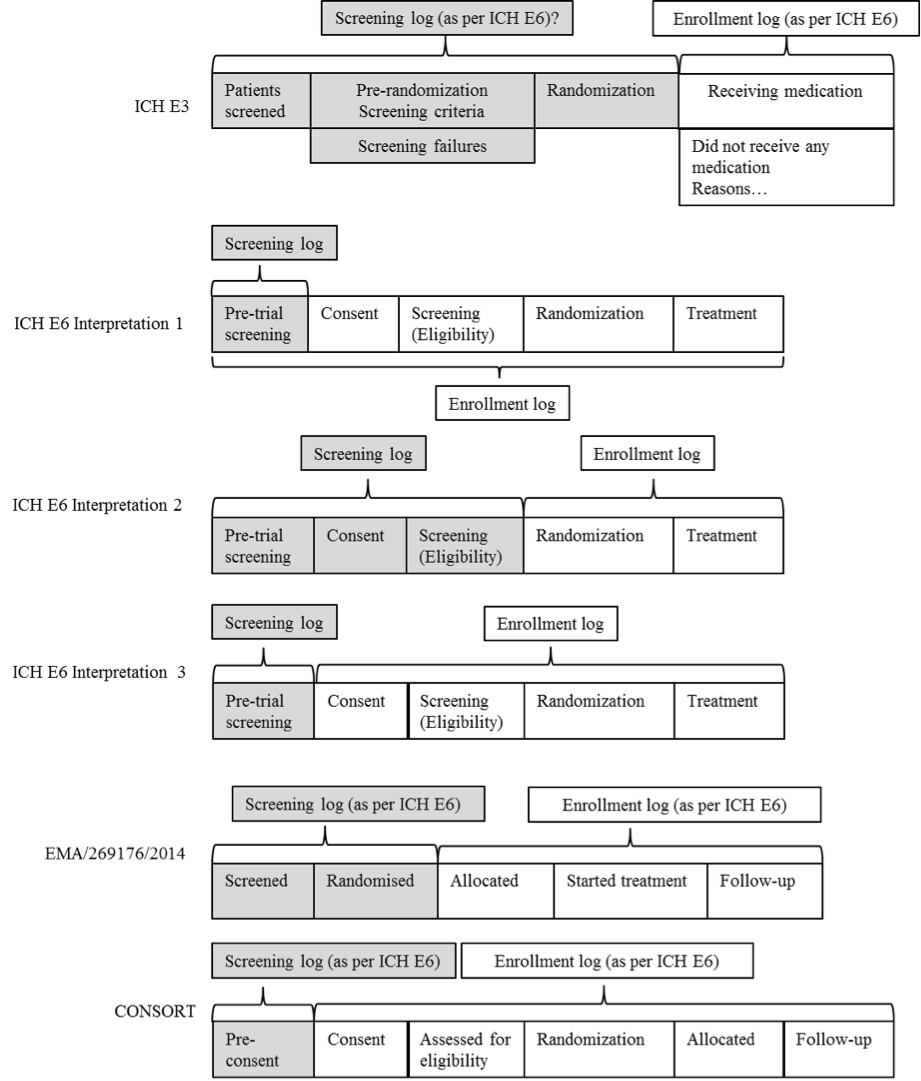
Figure 1. Different disposition interpretations based on some selected guidance documents. The permutations based on the ICH E6 guidance requirements with respect to enrollment and screening logs are shown for the clinical study report (ICH E3), good clinical practice (ICH E6) interpretations, the European Medicines Agency (EMA) assessor reporting guidance (EMA/269176/2014), and a CONSORT interpretation. Superimposing the ICH E6 screening and enrollment logs to other guidance disposition periods has been attempted to demonstrate the additional complication arising in the alignment across specialties.
Table 1. Selection of sources for subject disposition terms that potentially lead to inconsistencies in documentation (ICH E3, ICH E6, ICH E9, CDISC, CONSORT, and EudraCT).
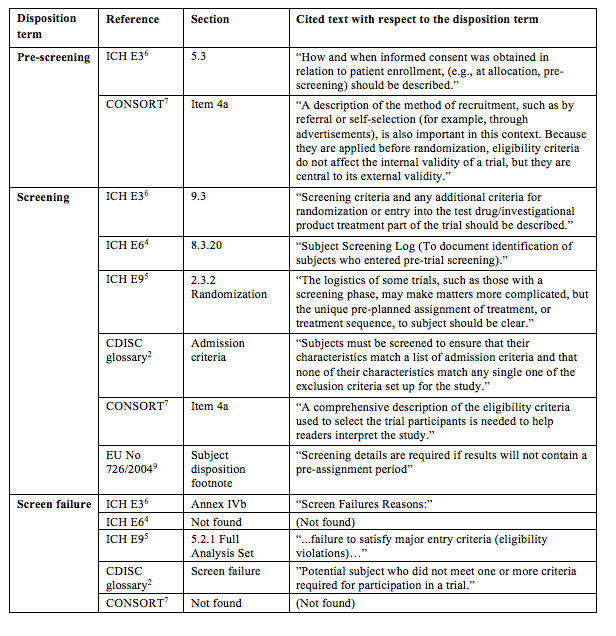
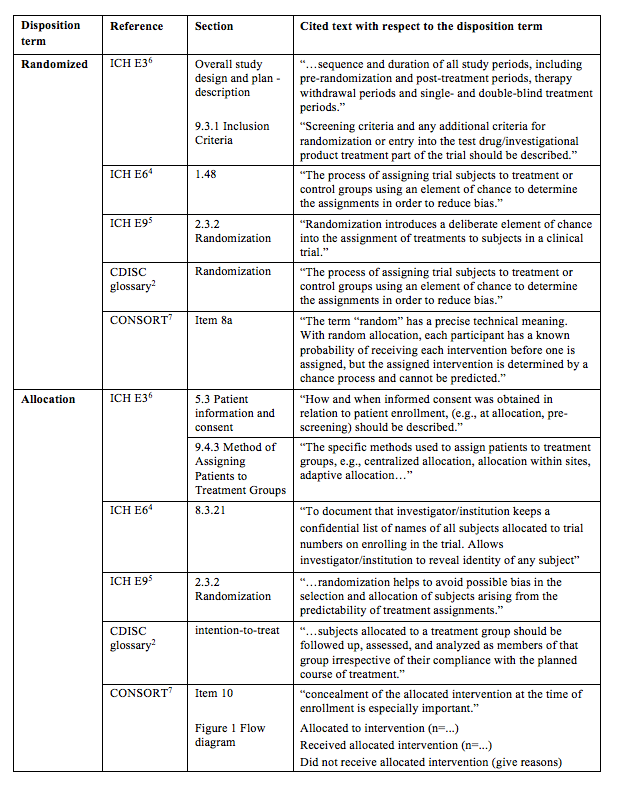
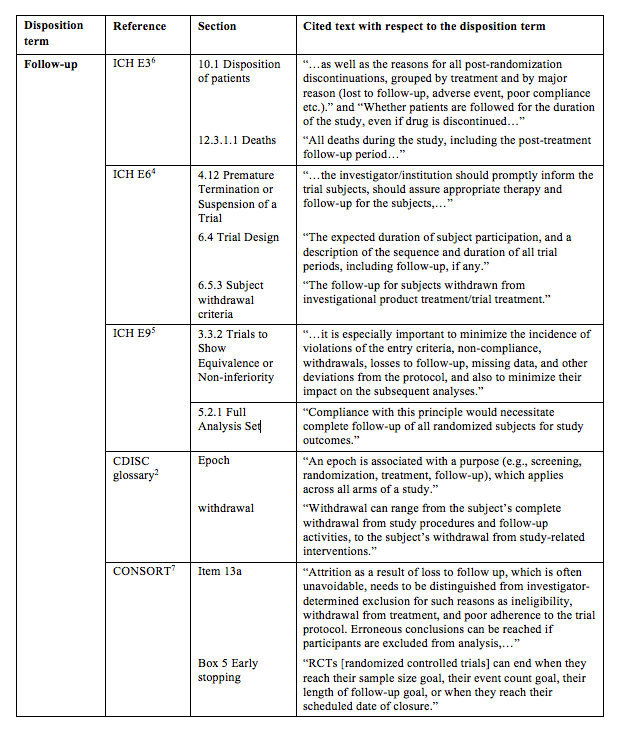
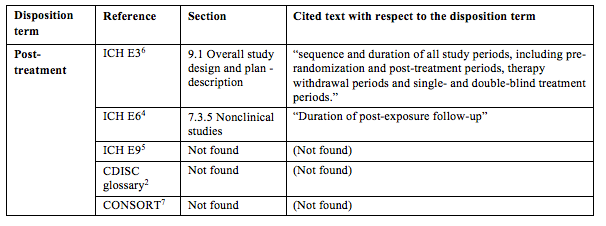
Initiatives to harmonize the reporting of the flow of subjects through a clinical trial give guidance. Many trials report subject disposition based on the cornerstones that are proposed by CONSORT, starting with enrollment, allocation and follow-up. CDISC has proposed a standardized term-“epoch”-to replace similar terms currently used (i.e., period, cycle, phase, and stage). The CDISC Subject Disposition (DS) domain in CDISC presents protocol milestones, including informed consent and randomization, disposition events, including study drug and study completion or discontinuation, and other events, including initial investigator assignment and investigator changes by subject. This article attempts to describe the processes that went into the planning of implementing CDISC and CONSORT standards in a mid-sized company.
The publically available CDISC glossary, CONSORT statement, and most commonly accessed ICH guidelines (ICH E3, E6 and E9) were initially reviewed with regards to specific subject disposition terms referring to trial epochs (timeframes): enrolled, entered, participated, screened, and withdrawn. Subsequently, all ICH Efficacy guidelines were reviewed in October 2014.
The first step taken was to scan the guidelines to assess how milestone dispositions were covered by existing terminology. The aim was to identify an already available guideline that covered disposition terms used by all specialties in clinical trials. The next step was to ascertain whether a simplification of milestone terminology could be achieved based on the reporting needs of a trial.
The decision-making on the internal preferred use of disposition terms is shown in Table 2. In addition, Table 2 provides insight into some of the sources and what the team felt were terms that have a similar, but not synonymous, usage. This oversimplified tabulation is designed to provide an insight into the complexity of what clinical study teams encounter in setting up systems and reporting to various internal line functions, as well as to external stakeholders. The resulting attempt at a harmonized disposition is shown in Figure 2.
Initially, the group focused on reporting of clinical trial result guidelines and limited to ICH E3, E6, and E9. The second step taken was to scan the guidelines to assess whether these milestones were covered by existing terminology (Supplement Table A). More than 70 disposition terms were counted in the review of current ICH guidelines. The review also found that there was no guideline covering all disposition milestones. The criteria applied for available terminology covered not only the requirement that the period was adequately described in the positive sense (i.e., meaning that a patient had reached the end of an epoch but also that a guideline had a term for a patient that did not reach the next milestone). For example, screening is defined in ICH E3 but screening failure is not described in the same guideline. The terms listed in Table 1 were identified to have the potential to be a source of misunderstanding. Thus, in the generation of Table 2, it has been attempted to match terms that from the review of the numerous ICH Efficacy guidance documents are used interchangeably for the same epoch.
An intuitive approach was attempted based on the CONSORT disposition flow and terms and then supplementing these. From a sponsor’s point of view data can only be collected if an individual has signed consent. Based on such fundamentals our group decided that besides signed informed consent, allocation to the investigational therapy, the administration of therapy and the following of the planned protocol therapy to completion were indisputable events in a trial. A key component of informed consent to participate in medical research is the understanding that research is not the same as treatment. The decision-making process leading to the generation of the consolidated milestone participant flow is outlined in Table 2 and presented in Figure 2. The disposition being separated into the pre-trial epoch, data limited for access only at the investigator site, and the epochs captured in a database. Once the subject has given consent, then the patient has entered (and is enrolled in) the trial. This results in a separation of screening to any activity that took place before consent and enrolled subjects being those that have given consent.
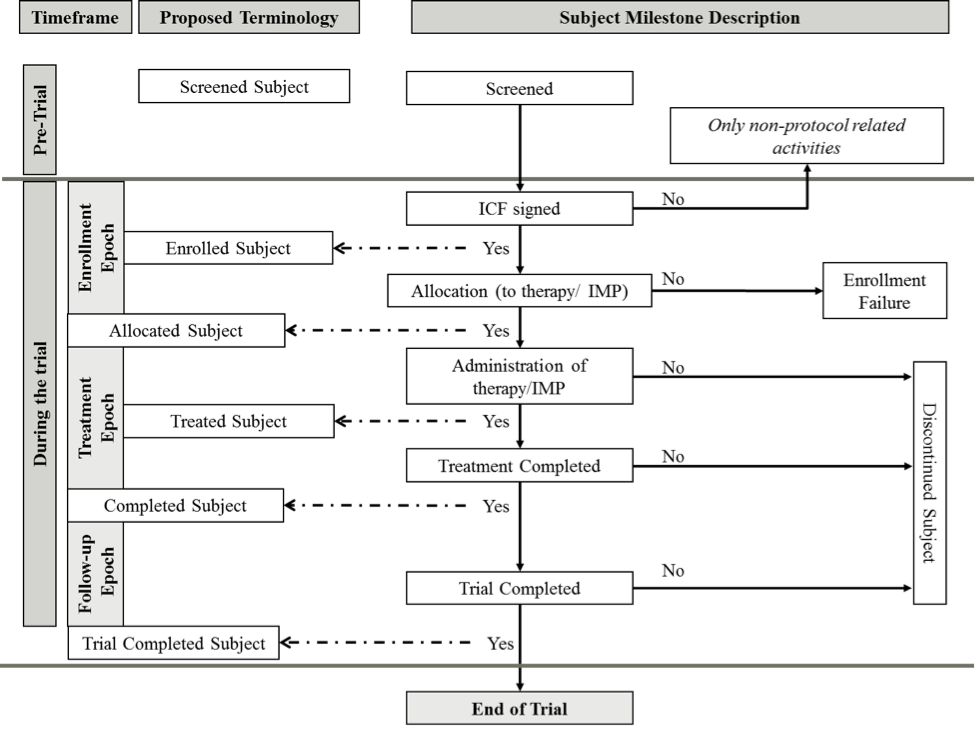
Figure 2. Proposed clinical trial subject disposition terminology based on subject milestones descriptions. The proposal is adapted from CONSORT. Screening has been separated from enrollment to avoid inconsistent use of these terms. The term “enrollment failure" has been coined to identify subjects that were not eligible for allocation to investigational medicinal product (IMP). Furthermore, the follow-up epoch has had terminology introduced to clearly distinguish between subjects that completed treatment and subjects that complete the trial with all planned procedures and visits. Randomization has not been added to this participant flow as explained in Table 2.
Table 2. Tabulated overview on how preferred disposition terms were derived at.
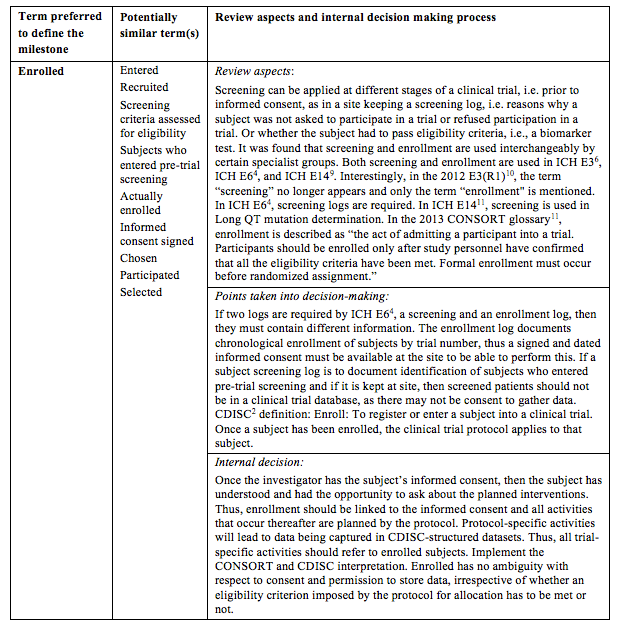
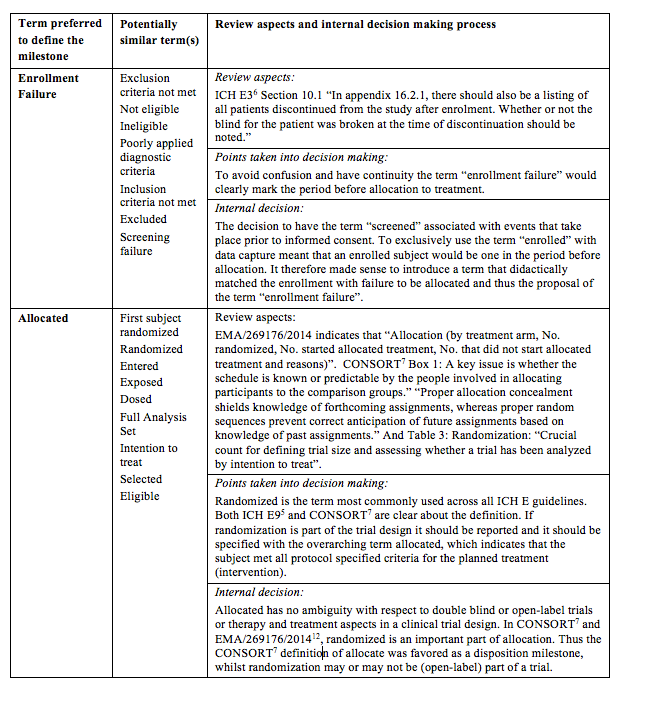
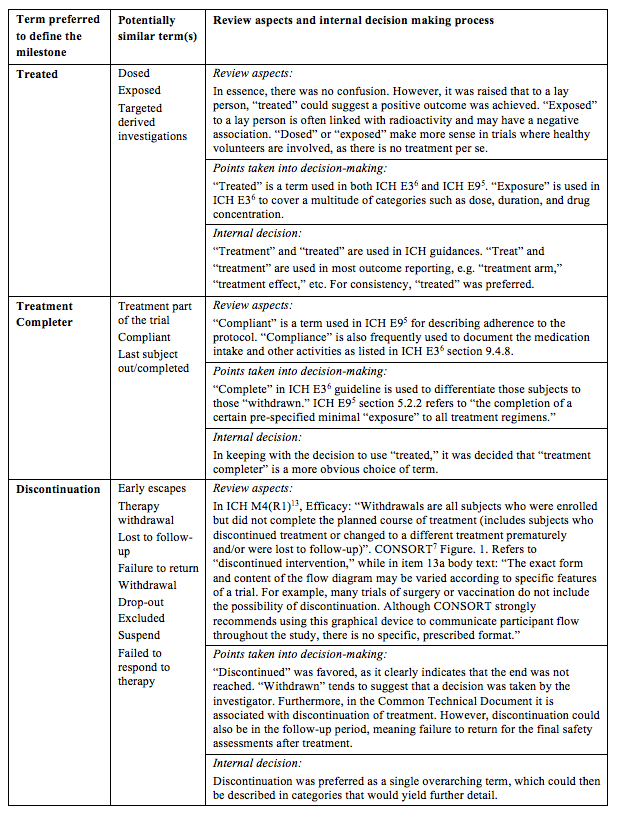
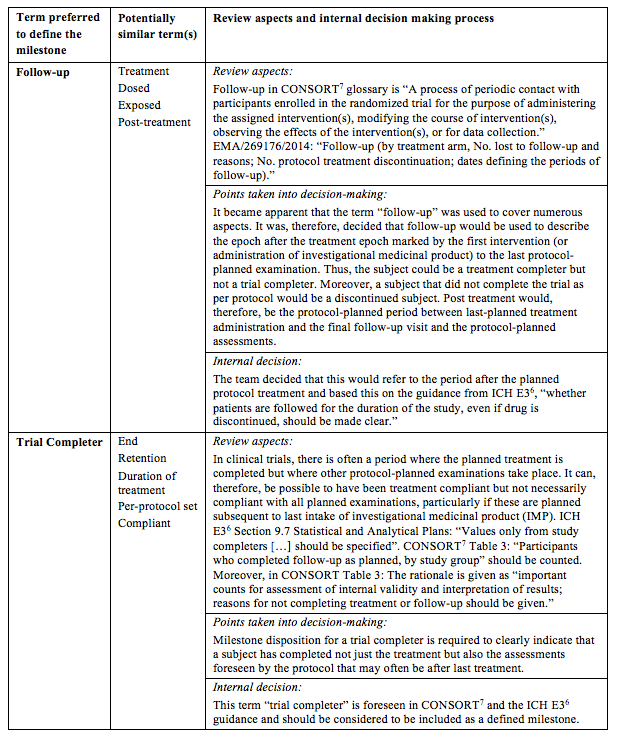
Discussion
It became clear during the discussions and the review of the ICH guidelines that there was good cause for the diversification of disposition terminology. It was also clear that each specialty had a need to define their trial-task activity trial milestones. There would not be need to discuss this topic if, as stated in ICH E9, “…all subjects randomized into a clinical trial satisfied all entry criteria, followed all trial procedures perfectly with no losses to follow-up, and provided complete data records, then the set of subjects to be included in the analysis would be self-evident.”This limited review led to the conclusion that there was currently no single guideline that comprehensively covered the disposition milestones used by all expert areas. The criteria that the team applied for available terminology covered not only the requirement that the period was adequately described in the positive sense (i.e., meaning that a patient had reached the end of an epoch but also that a guideline had a term for a patient that did not reach the next milestone. For example, screening is defined in ICH E3 but screening failure is not described in the same guideline. Similarly, CONSORT has enrollment but no enrollment failure, which arguably would didactically be easier for a layperson to understand.
It was also identified that the diversification of disposition terminology may lead to misinterpretation when results are reported. The earliest epochs in a trial had a tendency to use the greatest number of terms to describe patient disposition. It was noticeable that in the early clinical trial epochs, there was a tendency to use terms most indiscriminately. Entering, participation, eligibility, screening, and pre-screening with regards to enrollment potential leading to interesting misunderstandings as shown in Figure 1. If a subject decides to enter a clinical trial, he or she gives official consent by signing the document (CDISC glossary). Based on such fundamentals, our group decided that besides signed informed consent, allocation to the investigational therapy, the administration of therapy, and the following of the planned protocol therapy to completion were indisputable events in a trial.
Screening could be understood to either be pre-trial or to cover all activities up to randomization. Could a patient be screening failure if they did not consent? Or would a patient be a screening failure if they were not eligible for allocation, or was a patient that was not suitable for consent by the investigator a screening failure? Noted by the group and of interest was that there seems to be a tendency to use the term “screening” in older ICH efficacy guidelines (e.g., in the ICH E3 (R1) document from 2012, the term does not appear). It is proposed that screening be an activity that occurs prior to data capture and that this was based on events prior to informed consent. A biomarker test is often described as part of screening. However, screening may also be part of the process that investigators follow before requesting patients to participate in a clinical trial. This leads to the question around whether the biomarker is part of the protocol or part of routine clinical practice. This also allows for enrollment and screening logs to capture unique data and be associated with a subject’s disposition milestone reached based on the CDISC definition “to enter a patient into a clinical trial.”
Follow-up and treatment also cause misunderstanding. Some understand “follow-up” to be the period after treatment. Similarly, the seemingly simple term “post-treatment” resulted in different interpretations. Is post-treatment a period after “early discontinuation,” or after the end of trial, or after the end of protocol-planned treatment to the planned safety follow-up visit? Even past or present forms of a disposition terms such as “enroll” and “enrolled” have been found to be a source of confusion in a multinational team. Some colleagues understanding enroll to be part of an active process that may or may not lead to allocation, while others understand enrolled to be the act of documented consent. These seemingly insignificant differences appear not to be critical at first; however, they introduce inconsistencies that lead to misunderstandings, and need to be managed to avoid errors in trial interpretation. There is agreement with respect to randomization across guidelines and what mechanisms should be in place to prevent bias at and after randomization.
With the advent of greater clinical trial transparency and reporting requirements, we are encouraged by the initiatives of CONSORT and CDISC to harmonize standards. It is our hope that all clinical trials adopt a standardized disposition terminology; a sort of reporting dictionary agreed upon by all specialist groups that takes into account potential language barriers, which we have not reflected upon here.
To encourage harmonization, the following was found of help within our organization:
- Respect the specialist group’s definition of a term within their set of guidelines.
- Identify a guidance that has few disposition terms and has a broad acceptance, thus our preference to base disposition milestones on the CONSORT terminology. CONSORT terminology being referenced to in ClinicalTrials.gov, EMA/269176/201414, and publication of results in peer-review journals.
- Avoid terms that potentially have multiple meanings due to differentiated use by different experts (e.g., eligibility and screening). If these terms need to be used, it is recommended that they are further qualified (e.g., “biomarker screening” or “eligible for consent”).
- Care should be taken to avoid combining what may be perceived to be two milestone terms (e.g., “complete follow-up”).
- Cross-functional agreement on disposition terms and a clear understanding is essential to facilitate harmonized terminology. A single term for participants on treatment that complete the trial as planned (i.e., completed). A single term for participants that do not complete the trial treatment and procedures as planned (i.e., discontinued).
- Disposition terms should use the past tense when reporting trials or when giving project updates to avoid confusion.
- Avoid the use of additional disposition terms being introduced into clinical trial reports or protocols.
To enable transparency and understanding of analyses, a common use of terms in all clinical trial designs should be strived for.
References
1. Zink, RC and Mann, G. On the Importance of a Single Data Standard. Drug Information Journal. 46:362-367 (2012).
2. European Agency for Evaluation of Medicines (EMEA). ICH topic E6. Note for guidance on good clinical practice (CPMP/ICH/135/95).
3. European Agency for Evaluation of Medicines (EMEA). ICH Topic E9. Statistical principles for clinical trials. Note for guidance on statistical principles for clinical trials (CPMP/ICH/363/96).
4. International Conference on Harmonization (ICH) E3, “Structure and Content of Clinical Study Reports” (1996).
5. Moher, D, Hopewell, S, Schulz, KF, Montori, V, Gøtzsche, PC, Devereaux, PJ, Elbourne, D, Egger, M, Altman, DG. CONSORT 2010 Explanation and Elaboration: updated guidelines for reporting parallel group randomized trials. BMJ 2010;340:c869.
6. Minkenberg, R. Result disclosure on ClinicalTrials.gov first experiences and challenges. Pharmaceutical Programming; 3(2):51-56 (2010).
7. European Commission Health and Consumer Directorate-General. Technical guidance on the format of the data fields of result-related information on clinical trials submitted in accordance with Article 57(2) of Regulation (EC) No. 726/2004 and Article 41(2) of Regulation (EC) No 1901/2006. Ref. Ares(2013)73623-22/01/2013.
8. Henderson, GE, Churchill, LR, Davis, AR, Easter, MM, Grady, C, Joffe, S, Kass, N, et al. Clinical trials and medical care: Defining the therapeutic misconception. PLoS Medicine; 4(11): e324 (2007).
9. International Conference on Harmonization (ICH) E14, “The Clinical Evaluation of QT/QTc Interval Prolongation and Proarrhytmic Potential for Non-antiarrhythmic drugs” (2005).
10. International Conference on Harmonization (ICH) E3 Implementation Working Group. ICH E3 Guideline: Structure and Content of Clinical Study Reports Questions & Answers (R1)” (6 July 2012).
11. CONSORT Glossary. http://www.consort-statement.org/resources/glossary. accessed 30 Oct 2014.
12. European Medicines Agency. Guidance document for the content of the ËCo->Rapporteur day 80 critical assessment report. Clinical aspects. EMA/269176/2014.
13. International Conference on Harmonization (ICH) M4E(R1), “The Common Technical Document for the Registration of Pharmaceuticals for Human Use Efficacy – M4E(R1). Clinical Overview and Clinical Summary of Module 2. Module 5: Clinical Study Reports” (12 September 2002).
Improving Relationships and Diversifying the Site Selection Process
April 17th 2025In this episode of the Applied Clinical Trials Podcast, Liz Beatty, co-founder and chief strategy officer, Inato, discusses a number of topics around site engagement including community-based sites, the role of technology in improving site/sponsor relationships, how increased operational costs are impacting the industry, and more.
Behind the Buzz: Why Clinical Research Leaders Flock to SCOPE Summit
February 7th 2025In this episode, we meet with Micah Lieberman, Executive Conference Director for SCOPE Summit (Summit for Clinical Ops Executives) at Cambridge Innovation Institute. We will dive deep into the critical role of collaboration within the clinical research ecosystem. How do we bring together diverse stakeholders—sponsors, CROs, clinical trial tech innovators, suppliers, patients, sites, advocacy organizations, investors, and non-profits—to share best practices in trial design, program planning, innovation, and clinical operations? We’ll explore why it’s vital for thought leaders to step beyond their own organizations and learn from others, exchanging ideas that drive advancements in clinical research. Additionally, we’ll discuss the pivotal role of scientific conferences like SCOPE Summit in fostering these essential connections and collaborations, helping shape the future of clinical trials. Join us as we uncover how collective wisdom and cross-industry partnerships are transforming the landscape of clinical research.